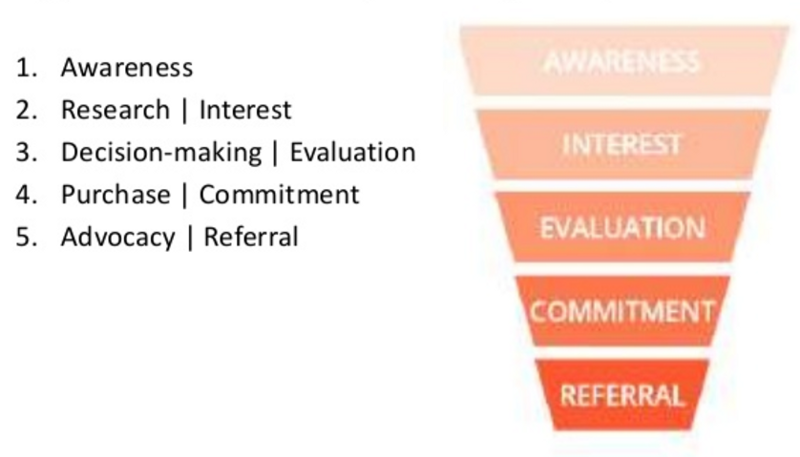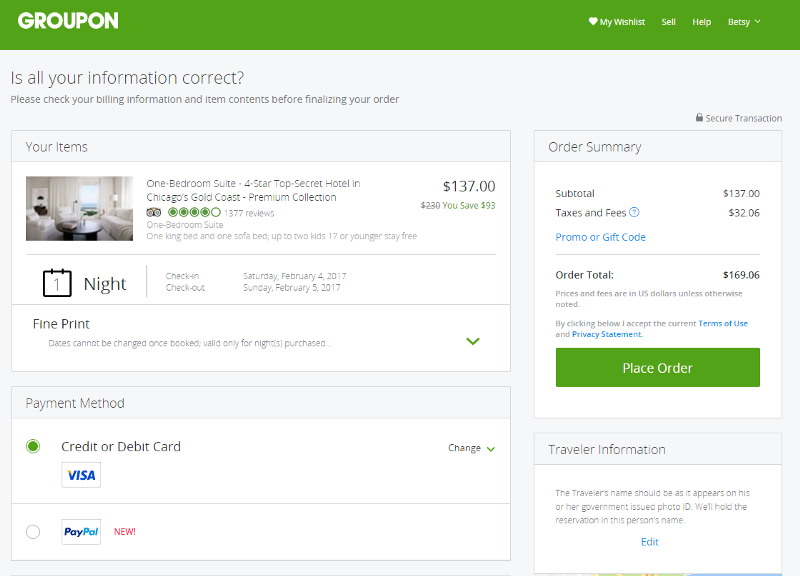Are you paying close attention to how your customers make their buying decisions?
You’ve spent some time doing your groundwork and figuring out a rough outline for your company’s marketing. You have a good idea about who your customer is, but what do you want them to do?
The answer is not as simple as just “click that link” or “buy my product”. You have to pay special attention to how your customer actually makes that decision because 57% of the buyer’s journey is completed before sales actually get involved. It’s called marketing funnels, and here’s the lowdown on how it all works.
TABLE OF CONTENTS
- What are marketing funnels?
- How do marketing funnels help?
- How do I design the right marketing activities for each phase of the marketing funnel?
- Marketing funnel example: Groupon.com
- Which marketing funnel metrics matter?
- Final takeaways about digital marketing funnels
What are marketing funnels?
In a nutshell, a marketing funnel is a set of steps a person goes through before they achieve a particular goal. Usually the end goal is a purchase, but often — particularly for affiliate marketers — it’s clicking through to another website or filling out a form. Marketing funnels are an efficient way to get your purchase process to work smoothly.
To get an idea of how the marketing funnel works, think about the steps you usually take before you buy something. Let’s say you want to buy a TV:
- You visit an electronics website.
- You browse the products and make your selection.
- You add your chosen TV to your cart.
- You make the purchase.
At every step there’s a key action you need to do in order to move to making a purchase . That explains the ‘marketing funnel’ name.
There are four steps to consider in the marketing funnel: Awareness, Interest and Evaluation, Commitment and Advocacy.

Think about it: At the beginning of the process, there are a slew of people who are taking the first step (or visiting a website). As people begin to travel further along in the purchase process (i.e. down the marketing funnel), some of them drop out, thus the crowd thins out a little bit. It’s kind of like if you were to tip rice down a funnel: a lot of grains go in the top, but the rate at which they come out the bottom starts to slow considerably.
How do marketing funnels help?
Marketing funnels can help your business in more than one way. Here’s an overview of the key funnel benefits:
1. Marketing funnels are easy to follow
One of the benefits of marketing funnels is the fact that they’re a relatively straightforward plan to follow. You can easily and quickly map out each stage of the customer decision process and plan what marketing activities you’re doing in each.
2. Marketing funnels can be used by any type of business
The beauty of marketing funnels is that they can be applied to virtually any consumer interaction, whether you’re an online store looking for sales, an affiliate marketer looking for some clicks, or a company wanting sales leads. The marketing funnel is a great way to clearly see all stages of the sales and marketing life cycle and according to Forrester, generate 50% more bottom of the funnel leads at 33% lower cost.
3. Marketing funnels help you measure your success and fine-tune your strategy
Another advantage of using the funnel is its measurability. You could be losing lots of customers before they even get to stage 2, so perhaps you need to work on your brand awareness. Or you might be wondering why you have a huge amount of drop-offs before the final conversion — maybe your shopping cart page needs work, or perhaps you need to do more personalised sales outreach.
4. Marketing funnels help you identify potential frictions in your selling process
Funnels are great for not only planning your activities, but also for seeing where you might have some weak spots.

According to Aaron Agius, Co-founder of Louder Online, no matter how much care and attention you’ve put into improving your funnel, there can still be cracks and leaks that can cause leads to slip away without ever making a purchase.
This is why it is crucial to properly map out your marketing activities in order to optimise and improve your return on ad spend for affiliate marketing.
How do I design the right marketing activities for each phase of the marketing funnel?
You can match your marketing activities to every stage of the funnel.
1. First phase on the marketing funnel: Awareness
The first stage — when the marketing funnel is the widest — is the most critical. You’re trying to drive awareness so that people learn about your brand or website. Think broad, big-picture stuff here: Get your website ranking high in search, look for opportunities for lead generation via white papers and blogs, and consider doing AdWords.
2. Second phase of the marketing funnel: Interest and evaluation
In the second phase of the marketing funnel things start to get a little more personalised. You can start doing more targeted communications to your customers, like email marketing, social media posts and even product demos if it suits your business. If you’re an affiliate marketer and you want your customer to click through to your partner’s website, you could look at doing A/B testing on certain pages to try to capture different audiences.
3. Third phase of the marketing funnel: Commitment
This is the final step in the marketing funnel before a purchase (or other conversion) takes place. A little reward to entice people to make the final leap can work well. For example, you could offer a discount code if they wanted to make the purchase that very day.
You could also get customers in the right frame of mind by helping them focus on the benefits after the sale. So, if you sell vitamins, you could write a blog post about how great people feel after taking a particular vitamin for 30 days.
This stage of the marketing funnel is a chance to ease any potential worries that may be stopping a customer from converting, and to also make the final conversion process as easy as possible. So if you’re an online merchant, make the checkout process easy; if your conversion goal is for people to fill out a form, make that form short and sweet.
4. Fourth phase of the marketing funnel: Advocacy
The marketing funnel doesn’t end after the conversion is made. You now have the chance to make these people more than just customers: They can be advocates for your brand. Repeat business and brand loyalty is fantastic, but customers in this final stage can be even more valuable as they spread the word about you.
Engaged, active customers can unknowingly become ambassadors for your brand, continuing your sales cycle automatically. The key marketing tool here is social media. Online reviews and a strong social community can do wonders for building your brand’s legitimacy in the eyes of future customers.
Marketing funnel example: Groupon.com

Groupon is still a major company reaching millions of consumers every month with personalised deals.
They have a very clear email opt-in pop-up on their site. It focuses your attention and has clearly been a successful strategy for growing their audience since they have continued to use it over the years.
Let’s examine the rest of their sales funnel to see how it works.
Steps in Groupon’s marketing funnel
- Homepage
- The pop-up on the homepage incentivises you to give your email address. You get a coupon code for $10 off $25 on your first order just for signing up.
- From there, you can browse and shop for services.
2. Internal homepage view offer details
- For example, Groupon in Chicago.

3. Purchase form

Which marketing funnel metrics matter?
All of the above might seem a lot, so the only method in staying focused with your key initiatives is by focusing on a few key metrics. Use data to make your decisions in revising expanding your performance metrics.
Some key marketing funnel metrics for you to consider include:
|
Metric |
Meaning |
|
Sales funnel conversions |
Prospects that enter the funnel and convert into customers |
|
Entry sources |
Sources people are entering your funnel from |
|
Time in stage |
How long it takes to go from awareness to advocacy |
|
Exit rate |
The number or percentage of people that fall out of a particular stage |
|
Engagement rate per stage |
The conversion rate or specific behavioural metric of your marketing activity |
|
Opportunity arrival rate |
Number of opportunities in your current funnel |
|
Close rate |
In comparison to sales funnel conversions, this looks at only those that move from decision to purchase |
There are many ways to track this including the use of CRM tools such as Hubspot and PipeDrive, Analytics and marketing automation software such as Google Analytics, Kissmetrics. You can also work on optimising your funnel by using heat map tools such as Crazy Egg and Clicktale.
Lead scoring can be also used to help prioritize your prospects.
Final takeaways about digital marketing funnels
We’ve gone through a fair amount, so here are some final takeaways:
- Pay special attention to how your customer makes a purchase decision; this is why marketing funnels exist
- Marketing funnels are easy to follow and can bring multiple benefits to your business
- Be creative when it comes to designing marketing activities; create an omni channel strategy that will help you engage your customers at different phases of the marketing funnel
- Keep track of your marketing funnel metrics to measure performance
- There are many tools you can use which map out, measure, fix and enrich your marketing funnel
What are your overall experiences and challenges of marketing funnels within your business? Please feel free to share this article.


